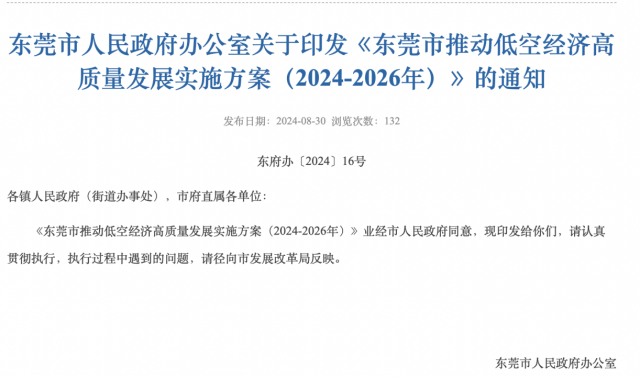Dongguan’s low-altitude economy is “taking off at an accelerated pace.” Recently, the “Implementation Plan for Promoting the High-Quality Development of the Low-Altitude Economy in Dongguan (2024-2026)” (referred to as the “Plan”) was issued. The “Plan” focuses on five major implementation projects: coordinated planning and promotion, industrial ecosystem optimization, technological innovation guidance, application scenario demonstration, and the construction of a flight support system. It outlines 20 key tasks, aiming to establish an industrial system by 2026 that centers on the R&D and manufacturing of low-altitude aircraft and is driven by low-altitude application scenarios. The “Plan” aims to significantly enhance the low-altitude flight service support capabilities, making the low-altitude economy a new and important growth driver for Dongguan’s high-quality economic development.

Dongguan is deeply integrating into the province’s low-altitude economy industry chain. According to the “Plan,” Dongguan will strengthen its connection with cities like Guangzhou and Shenzhen in the planning and layout of low-altitude infrastructure, including ground support facilities, low-altitude information infrastructure, and flight “route networks,” as well as enhance industrial collaboration with leading enterprises in the low-altitude economy.
Dongguan’s “position” in the low-altitude economy industry map is also becoming clearer. Industries such as new energy, high-end equipment manufacturing, next-generation electronic information, and new materials will receive key support from Dongguan. Adaptable technologies and products like electronic components, core sensors, and LiDAR, as well as critical components such as batteries, motors, electronic controls, propellers, composite materials, and aluminum-magnesium alloys, will be focal points for developing Dongguan’s low-altitude economy industry. By 2026, Dongguan is expected to attract over 200 enterprises in the industry chain, with the industrial scale exceeding 50 billion RMB.
Various towns, subdistricts, and (industrial) parks will see a vibrant flourish of different platforms. The “Plan” specifies that towns and subdistricts with industrial cluster potential across the city are encouraged to develop specialized industrial parks. Xiegang Town, leveraging the industrial foundation of the Yinping High-end Equipment Industrial Base, will create a manufacturing cluster for low-altitude aircraft; Songshan Lake, building on its technological R&D strengths, will establish an innovation platform for key technologies in low-altitude aircraft; Hongmei, with its test flight facility, will develop a drone innovation incubation and comprehensive service cluster in the Waterfront Economic Development Zone. Humen, Shatian, and Changping, based on their solid foundation in express logistics, will build a drone logistics and delivery industry cluster; and Binhaiwan, utilizing its advantages in tourism and technological innovation resources, will plan to establish an experimental zone for emerging consumption and innovative services.

Relying on Dongguan’s solid foundation in component manufacturing, Binhaiwan is actively engaging in deep cooperation with leading low-altitude aircraft companies to jointly explore complete aircraft R&D and production. The image shows an aerial view of Binhaiwan.
Dongguan will also leverage investment promotion as a driving force to seize new opportunities in the manufacturing of eVTOL (electric vertical take-off and landing aircraft), flying cars, unmanned helicopters, and industrial-grade unmanned aerial vehicles (UAVs). The city plans to intensify efforts to attract key segments of the low-altitude economy industry chain and leading enterprises, gathering a group of top companies in UAV complete aircraft R&D and industry solutions. Supporting industries such as low-altitude operations, full-cycle flight maintenance, low-altitude flight training, and UAV pilot training will also be poised for “take-off,” continuously improving the industrial ecosystem and enhancing the industry’s added value.

Technological innovation is the “wings” for the low-altitude economy industry’s take-off. Dongguan University of Technology has received support to establish the International Aerospace Technology Research Institute, which will conduct research on the development strategies, R&D layout, and technological innovation of the low-altitude economy industry. The university plans to build a pilot testing platform for intelligent unmanned terminals and implement a strategic plan to attract leading scientific talent, gathering more innovative professionals.
New “low-altitude economy” scenarios will continue to emerge. Dongguan has proposed constructing a smart logistics demonstration for low-altitude operations, focusing on the development of emerging logistics methods such as urban drone delivery and intercity drone transportation. The city will explore opening low-altitude logistics routes between the airport center and high-tech enterprises within the city, as well as establishing cross-border logistics routes between the airport center and Hong Kong Airport. The low-altitude economy will also comprehensively empower the High-quality Development Project for Guangdong Counties, Towns and Villages, enhancing the UAV command and dispatch system.
The high-quality development of the low-altitude economy relies on the construction of a flight support system. Dongguan will classify and designate low-altitude airspace and routes, gradually relaxing no-fly restrictions. It will construct low-altitude general aviation airports, vertical take-off and landing points, logistics distribution stations, and other take-off and landing facilities as needed. In addition, the city will build communication, surveillance, and low-altitude meteorological monitoring networks, develop a comprehensive low-altitude digital map, and improve the efficiency of low-altitude flight management and approvals.
Moving forward, Dongguan will establish a dedicated task force for the high-quality development of the low-altitude economy, formulate policies such as the “Dongguan Low-Altitude Economy High-Quality Development Implementation Plan” and several measures to promote high-quality development in this sector. The city will also introduce the “Dongguan Low-Altitude Airspace Classification and Layering Plan and Route Network Design,” as well as the “Dongguan Low-Altitude Flight Take-off and Landing Point Layout Plan.” Additionally, Dongguan will form an industry alliance, explore the establishment of a municipal low-altitude economy industry development and operation service company, and plan to set up a Dongguan Low-Altitude Economy High-Quality Development Industry Fund. The city will make full use of public spaces such as squares, parks, and the urban sixth facade to facilitate the deployment of low-altitude infrastructure.



